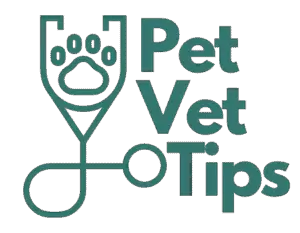This article contains affiliate links, and we may earn a commission at no cost to you if you choose to purchase through these links. I never recommend products that I do not trust or will not advise my veterinary clients and patients to use.
Don’t be fooled by the sugar in their name! Although they would want to eat sugar all day every day, this can quickly lead to obesity.
Sugar gliders have a wicked sweet tooth! It’s easy to unintentionally overfeed our pet sugar gliders on their favorite sweet treats, quickly leading to weight gain. Obesity will severely impact a sugar glider’s quality of life as it will cause them to struggle to be able to play and jump.
The diet of a wild sugar glider is more protein-rich than most sugar glider owners realize, with the most significant part of their diet consisting of insects, worms, and small bird eggs. On occasion, they will eat fruit or nectar but will often have to forage for some time before reaching a sweet treat. Therefore, the sweet stuff is not a daily part of a wild sugar glider’s diet.
Is My Sugar Glider Overweight?
The average body weight of a sugar glider is 3-5 ounces (90 – 140 grams) for females and 4-6 ounces (110-170 grams) for males. Body condition scoring is the most reliable way to determine whether your sugar glider is overweight.
The weight range above is rather extensive and may be unreliable, so similar to humans, your glider’s ideal body weight will depend on their build and genetics.
Body Condition Scoring
A sugar glider’s body condition score is done by looking at the amount of soft tissue (muscle and fat) covering their skeleton. This article will look at a body condition scoring system of 1 – 5.
The ideal body condition should be between 2.5 and 3.5 out of 5, where 1 is emaciated, and 5 is morbidly obese.
| Body Condition Score out of 5 | Features |
| 1 | Little to no muscle on hindquarters. Pelvic bones clearly visible, and ribs are easily felt and may be visible. Visibly emaciated. |
| 2 | Some muscles can be felt in the hindquarters, but a slight outline of the pelvis can still be seen. Ribs are easily palpable but not visible. |
| 3 | A good amount of muscle and soft tissue is felt over the spine and pelvis. Ribs can be felt when applying some pressure. |
| 4 | The spine, pelvis, and ribs are hard to feel. Abdomen rounded and slightly drooping. Chest thick and soft. |
| 5 | The Chest is very large, and ‘folds’ of fat tissue may be seen. Noticeable fat accumulation in the gliding membrane and glider appears overall round. |
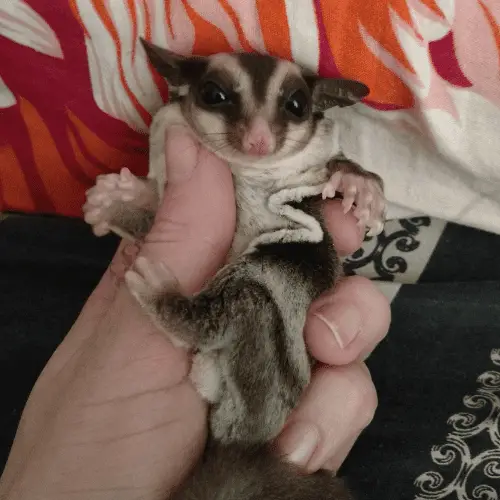
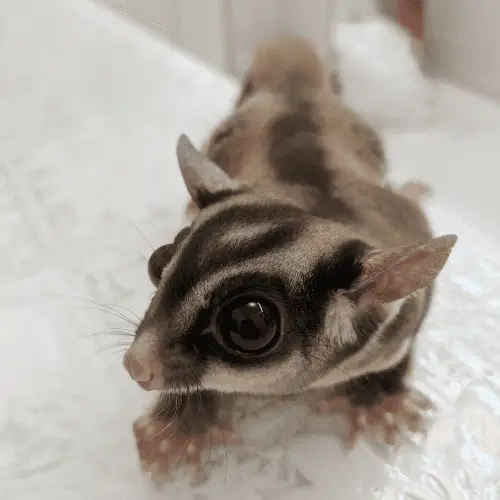
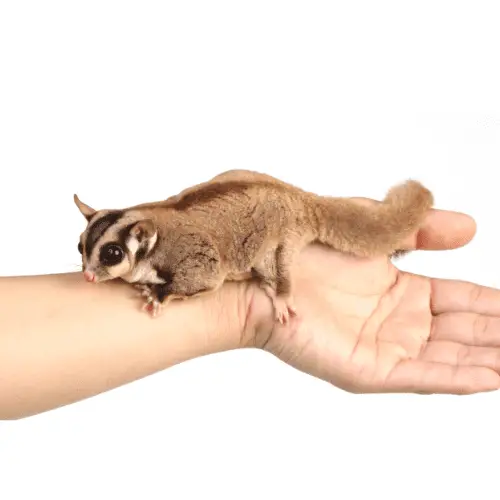
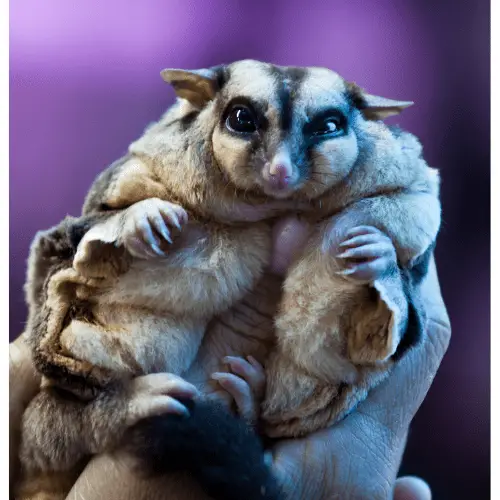
Another way to determine your sugar glider’s body condition score is to feel the muscle covering the spine. The top of the vertebral bodies (spine bones) should be palpable but not visible. You should be able to see a soft triangular shape at the top of your glider’s spine. The tissue on either side of the spinous processes should not bulge. See the diagram below for more detail.

Why Is My One Sugar Glider Fatter Than My Other Sugar Glider(s)?
Dominance Hierarchy
If you have more than one sugar glider, you might find that one of them is way more enthusiastic about food and may even show signs of aggression if the other glider(s) comes close to the food bowl while the little food hogger is eating. These gliders are often heavier than the other, obviously due to eating more than their cage mates.
Pregnancy/Lactation
If you have a female sugar glider that is kept with an in-tact male sugar glider, this is always a possibility. Pregnant and lactating sugar gliders may also become more food aggressive.
If the breeding was unintentional or you do not plan on breeding your gliders, it is best to have the males castrated.
Health Conditions
Like humans, certain health conditions such as thyroid and other hormone issues can lead to unintentional weight gain.
If your glider is showing any additional symptoms or does not seem to be able to lose weight despite the necessary dietary and activity adjustments, consult your vet about the needed steps to check for health conditions.
Age
Healthy middle-aged to older sugar gliders are often slightly heavier than their younger counterparts. This is simply due to eating just a little too much over many years, leading to slow weight gain.
Health Consequences Of Obesity In Sugar Gliders
Most people know that excess body fat is pro-inflammatory and causes all kinds of metabolic havoc that negatively impacts long-term health. Of course, this is true for sugar gliders, just as it is for humans, and while body fat plays an essential role as an energy reserve, you hardly need a reminder that too much is not a good thing!
Arthritis
Carrying around excess body weight causes an abnormal load on joints. This leads to inflammation and degeneration of bone and cartilage in joints in the long run.
This has a snowball effect as painful joints will cause your glider to move around less, leading to more weight gain.
Heart and Liver Disease
Excess body weight puts excessive strain on the heart and liver. A sugar glider’s liver plays an integral part in converting extra energy into fat and then converting fat into glucose to be used as energy again.
When a substantial amount of fat is converted into glucose quickly, this can overwhelm and potentially damage the liver. Luckily this damage is temporary and reversible with weight reduction.
Shortened Life Span
The ultimate downside of your sugar glider being overweight is that they will have a shortened life span. Longevity has been the subject of many research studies in many different species. The one factor that seemed to apply in all species is that maintaining healthy body weight and preventing obesity is the most reliable predictor of a longer life span.
Causes Of Obesity In Sugar Gliders
Note that it is normal for sugar gliders’ appetite to increase and for them to gain some weight as the winter months approach, but if your sugar glider is approaching a body condition score of 4 out of 5, it is time to investigate the possible causes.
Poor Diet
An active sugar glider will eat 10-15% of their body weight in food every day. It is easy to forget that sugar gliders are tiny compared to humans. One nut may feel like nothing to us but can be a considerable amount of calories for a tiny sugar glider body.
Commercially made sugar glider feed is good, but similarly to how humans should ideally not get all their nutrition from ensuring every day, I do not recommend feeding a diet of solely formulated feed. We are only now realizing the adverse effects that ultra-processed feed has on our animal companions. Instead, a variety of fresh whole food should be fed on a daily basis.
For more information on a species-appropriate sugar glider diet as well as examples of healthy treats, have a look at this article.
Gliders do not need to eat treats. Avoid feeding yogis as these are filled with sugar with limited nutritional value. I would rather leave them out of my glider’s diet as there are many other snacks to offer that your gliders will enjoy much more.
Insufficient Exercise
Wild sugar gliders will spend most of their waking hours foraging for food, jumping from branch to branch, and escaping predators.
Pet sugar gliders kept in a comfy cage with easy access to food do not keep nearly as fit and active as their wild counterparts.
Health Conditions
As mentioned above, certain endocrine conditions can cause unexplained weight gain. If you suspect this, you need to take your sugar glider to a vet who is familiar with sugar gliders.
How To Help My Sugar Glider Lose Weight
1. Feed Lower Calorie Food
Sugar gliders can be pretty picky eaters if they have grown used to high-calorie sweet foods, so do not be surprised if they refuse to eat the healthier options. This is where you will have to exercise some tough love.
Your glider will definitely not starve themselves to death, and they will eventually become hungry enough to eat the healthier options. Eventually, they will get used to a more nutritious diet and enjoy eating lower-calorie nutritional food.
If you would like to learn more, I provide a list of healthy snacks as well as a sample diet in this article.
Reduce the amount of sugar and corn you feed
do not feed more than 3-4 mealies per glider per day.
High-Calorie Food That Should Only Be Fed In Moderation
- Honey
- Crickets: high in fat)
- Nuts: one nut is a large serving for a sugar glider
- Corn: Corn is high in carbohydrates and low in nutritional value. In addition, it is high in phosphorus which will make you glider prone to a calcium deficiency if large amounts are given
- Yogurt drops: as mentioned before, this is very high in sugar and has nearly no nutritional value
- Dried fruit: calorie-dense and full of sugar, not to mention it may have added preservatives. Rather feed small amounts of fresh fruit.
Sugar Glider- Safe Low-Calorie Food
- Boiled chicken
- Carrots
- A small amount of plain yogurt
- Hard-boiled egg
- Dubia Roaches
- Apples
2. Feed Less Frequently
It is best to feed your sugar glider at dusk. As nocturnals, this correlates to their natural feeding time. If you find that your glider is still hungry in the morning or they seem to finish their food early during the evening, you can provide another small meal or snack early morning.
Adult sugar gliders do not need access to food all day long. This will prevent food spoilage and obesity.
3. Encourage Physical Activity
A Running Wheel
Sugar gliders love to use a running wheel! If you do not already have one, I would highly recommend that you get one.
A few important things to remember when looking for a running wheel:
- Sugar gliders not only run but jump inside running wheels. The wheel needs to be large enough for them to make small leaps in
- There need to be small openings on the running surface of the wheel for urine and feces to be let out to prevent them from making a mess
- The openings on the running surface must be of such nature that their toes will not be able to get stuck while running
Here are a few good running wheels available on Chewy and Amazon:
- Suncoast Sugar Gliders Wodent Wheel Senior Plus Nail-O-Matic™ Insert & Tail Shield (best pick)
- Kaytee Comfort Small Animal Exercise Wheel
- Exotic Nutrition Silent Runner Small Animal Exercise Wheel
Teaser toys, Foraging Toys, And Climbing Ropes
Dangling, feathery cat toys can provide hours of fun for sugar gliders. If you want to make it even more interesting, add a few healthy treats to the toys for them to retrieve. This foraging pineapple toy, for example, is great for hiding healthy treats in.
A climbing toy such as this climbing vine or these climbing ropes are a great way to get your gliders to climb and move around more.
Foraging Tree
Building a foraging tree using plastic and felt can be a rather large DIY project but is guaranteed to get your sugar gliders climbing and exploring. See the example of a homemade felt climbing tree below.
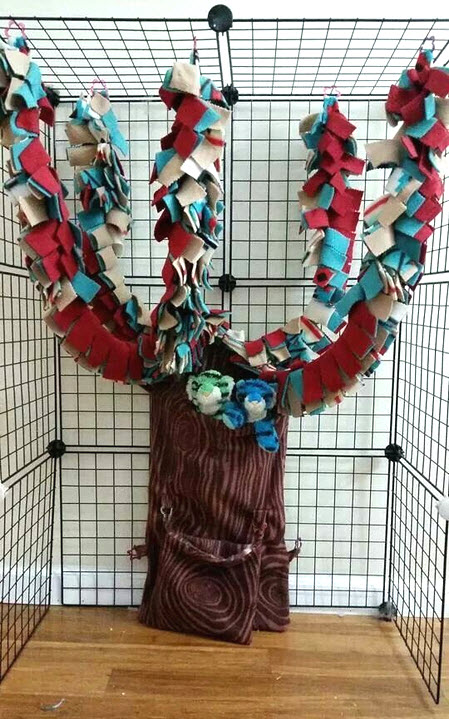
Jumping Exercises
If your glider is tame and well bonded to you, you can encourage your glider to exercise by jumping from objects to you in a safe place in your home. Offer them a small treat if they complete a jump. Get creative! Some gliders love this type of exercise.
Conclusion
Obesity can be detrimental to the health of your sugar glider. Overfeeding and under-exercising are the most common causes of obesity in pet sugar gliders.
By feeding a species-appropriate balanced diet and encouraging foraging and exercising, will help prevent obesity and the associated health conditions in your sugar glider.
Resources
- Banks, R., 2013. Exotic small mammal care and husbandry. Hoboken: John Wiley, pp. 157 – 168. https://onlinelibrary.wiley.com/doi/book/10.1002/9781119265405
- Dierenfeld, E., 2009. Feeding Behavior and Nutrition of the Sugar Glider (Petaurus breviceps). Veterinary Clinics of North America: Exotic Animal Practice, 12(2), pp.209-215.
- Dierenfeld, ES, Whitehouse-Tedd, KM. Evaluation of three popular diets fed to pet sugar gliders (Petaurus breviceps): Intake, digestion and nutrient balance. J Anim Physiol Anim Nutr. 2018; 102: e193– e208.
- Dierenfeld, E., Thomas, D. and Ives, R., 2006. Comparison of Commonly Used Diets on Intake, Digestion, Growth, and Health in Captive Sugar Gliders (Petaurus breviceps). Journal of Exotic Pet Medicine, 15(3), pp.218-224.
- Johnson-Delaney, C., 2014. Captive Marsupial Nutrition. Veterinary Clinics of North America: Exotic Animal Practice, 17(3), pp.415-447.
- Meredith, A. and Redrobe, S., 2002. BSAVA manual of exotic pets. 4th ed. Quedgeley: British Small Animal Veterinary Association, pp. 102 – 106 25. https://www.researchgate.net/publication/240493099_The_BSAVA_Manual_of_Exotic_Pets_4th_edn
